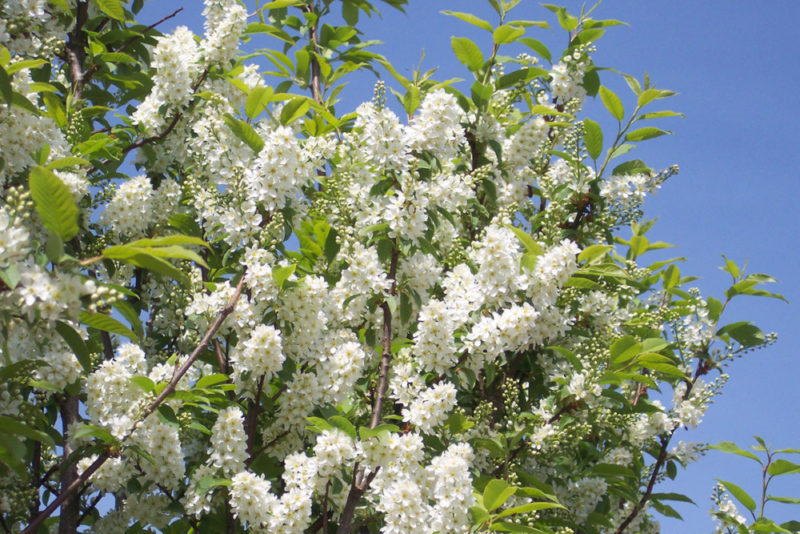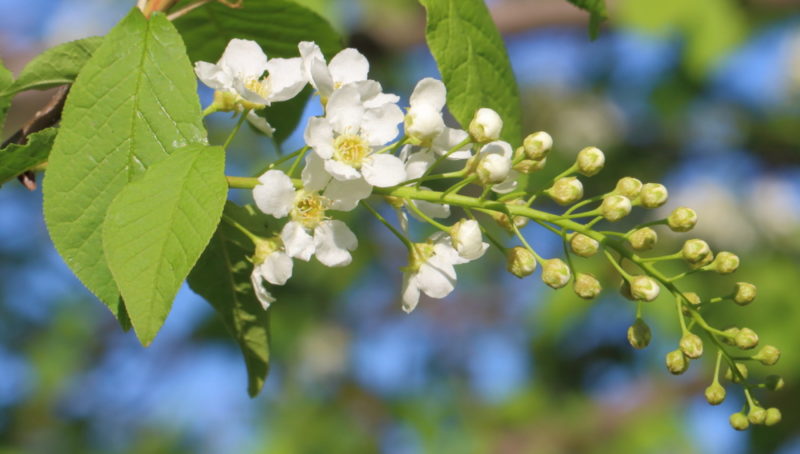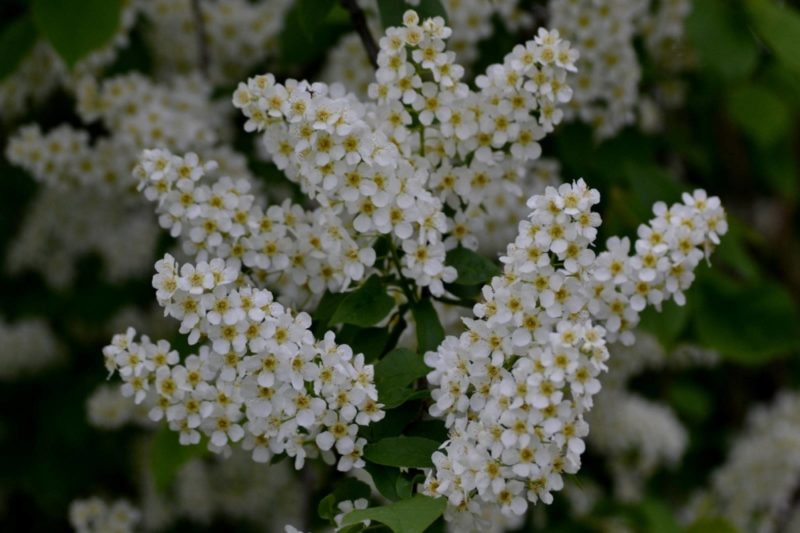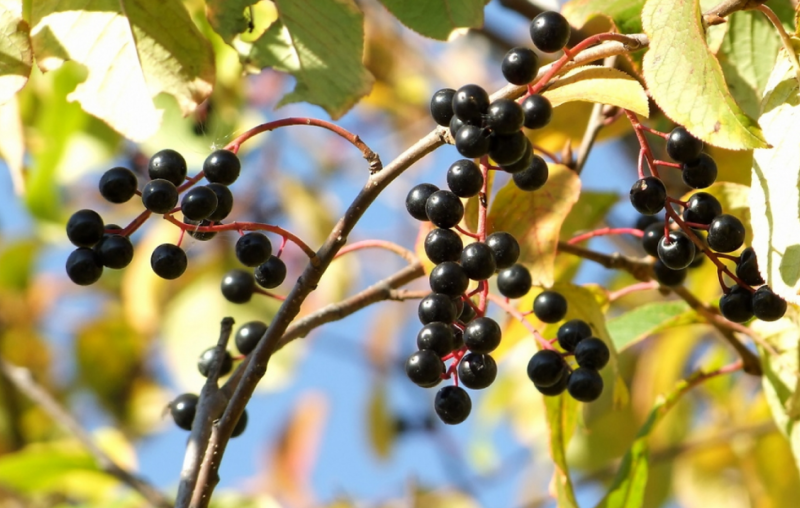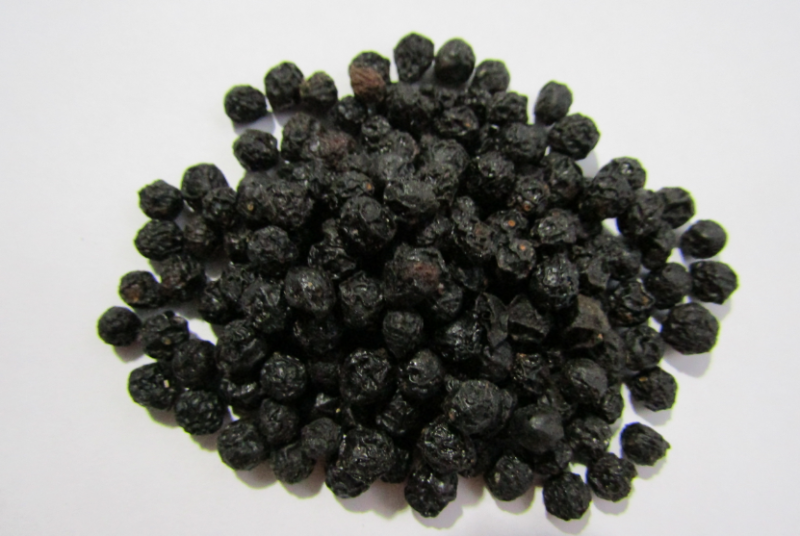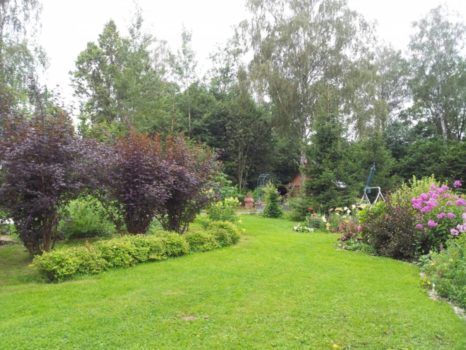In the midst of a spring thaw in the bosom of awakening nature, trees of Bird Cherry are covered with a lush white outfit - as the people call the Bird cherry Ordinary. Since ancient times, it has attracted the attention of healers and culinary specialists, and its stupefying honey aroma warns gardeners about imminent cooling. The unpretentiousness and splendor of flowering bird cherry encourages breeders to breed all its new decorative forms.
Material Content:
Botanical description of bird cherry
In the natural habitat, bird cherry grows on different soils in the forest and steppe zones of the European part, Asia, North Africa. In Russia, it can be found both in the Far East and in the northern regions, where its range reaches the forest-tundra. For example, in Murmansk, Buryatia, it is protected by law, and is found everywhere in the middle lane.
Lush flowering is observed on the sunny edges, along the banks of rivers and lakes, on forest glades with nutritious soil and close occurrence of groundwater. Species diversity totals about 20 copies. More common is Bird cherry Common.
Type Description:
- Large deciduous trees, less often a large shrub, average height - 10 m.
- The root system is superficial, with a shallow occurrence, but powerful, gives root growth.
- Crohn - 4 - 8 m in diameter, widely ovoid, dense, creates a dense shadow.
- The trunk is short, thin, not exceeding 25 - 30 cm in cross section.
- The bark of the trunk is matte, dark brown, covered with cracks. On young branches - green and dark cherry with a large number of light lentils. The lower layer is yellowish, with a bitter notes of a specific smell.
- The flowers are white five-petalled, about 1 mm, with 5 sepals and 20 long stamens with yellow anthers. Collected in a drooping loose, racemose 12 cm inflorescence with a honey-almond strong aroma.
- Leaves alternate on short petioles 1 - 2 cm, having small glands at the base. The top is smooth and matte, the bottom is slightly wrinkled. Ovoid with a sharp tip, sharp-edged along the edge.
- Fruits - black spherical shiny drupe up to 8 mm in diameter, sweet and astringent to the taste, inside have a hard round bone and dark purple flesh.
Depending on the region, the Bird cherry Common blooms the very first of all varieties - in April or May, about 2 weeks. During this period, it exudes a thick, far-carried smell.
Culture refers to androgenic, that is, requires cross-pollination.
After flowering, the crown of the Common Bird-cherry-tree retains decorativeness - among the thick bluish-green with a bluish tint foliage, brushes of greening and then reddening fruits are visible. They ripen in late July, and in the northern regions - in September. In autumn, the tree is covered with picturesque shades of crimson and whitish yellow.
Thanks to selection, it has spectacular forms with weeping branches, double flowers, with pink petals, variegated leaves, and even with yellow fruits.
Useful properties of the plant
All parts of the plant have phytoncidal properties, so bird cherry, by right, can be considered an orderly of the forest and garden.
- A powerful ramified root system is the creator of the natural soil drainage in the garden. Deciduous litter deoxidizes the soil, increases its productivity.
- Great honey plant. Honey production is 25-30 kg per 1 ha.
- The bark, flowers, leaves and berries of bird cherry are used in medicine and cooking.
- The extract from the bark of young twigs is used by gardeners as an ecological insecticidal and fungicidal agent for plants throughout the season.
- You can use this tool to scare away flies, mosquitoes and ticks, spreading the extract, without fear, the face and exposed parts of the body.
- Leaves are used to produce green dye for tissue and skin, and fruits are gray with a green tint or red. The bark gives a dark brown tint.
- Essential oils are used in cosmetology.
- Adult wood is solid, durable, well processed and polished, and is valued in carpentry. Flexible young twigs are used in weaving baskets, rugs and other crafts.
Choosing a place to land
Considering the androgenicity, soil and moisture preferences of Bird cherry Common, the density of the crown, creating a dense shadow, for lush flowering and fruiting of the tree, the choice of location is almost of primary importance.
Bird cherry blooms better in an open, spacious, sunny place. Count on planting 2 trees for cross-pollination (it is possible and different varieties, only with simultaneous flowering). The minimum distance between them is at least 5 m.
Bird cherry prefers loam, but also grows on other soils, if only the earth was loose, neutral or slightly acidic. Close occurrence of groundwater in the area contributes to its growth.
Features of planting bird cherry in the garden
Planting bird cherry is made in the spring or in the fall.
The plant is unpretentious, seedlings take root well, they don’t even need to prepare nutritious soil, and an abundance of organic matter, on the contrary, will adversely affect the growth and condition of the vegetative parts.
- A standard 50x50 hole is dug up.
- The bottom is covered with a layer of dry leaves, you can add a little peat or compost soil and 2 tbsp. l superphosphate.
- Before planting, the roots are carefully inspected. Dry and diseased are removed.Too long are shortened to 40 - 50 cm. Slices of roots can be sprinkled with ash.
- In the landing pit, the roots are straightened and covered with earth to the root neck. Make sure there are no voids left.
- The soil around is well compacted and spilled with a sufficient amount of water.
- The trunk circle is lined with sawdust or another mulch to preserve moisture.
There is no need to cover seedlings for the winter - they are frost-resistant. Cherry blossoms for 3 to 5 years of life.
Outdoor Care
Bird cherry ordinary - a lowly plant, does not require special care. Young seedlings are loosened up soil, weeds are removed, they are watered regularly and often until they take root, then only as necessary. In too dry summers, even mature trees can be watered so that the flowering season will be lush.
For top dressing, you can use the earth of your own leaves. Mineral fertilizing depends on the composition of the soil on which the tree grows. Do not forget the main rule of agricultural technology - it is better not to feed.
But sanitary pruning will only add decorativeness to the tree, especially since bird cherry tolerates the formation of the crown well. It is carried out annually, removing dry, sick, thickening crown branches and trunk shoots. Large sections are covered with garden varieties, as they are the site of penetration of pathogens.
Forming pruning can also be carried out by creating a standard tree from the plant.
In this embodiment, when planting a seedling, a crown of up to 60 cm is cut so that the skeletal branches of the first tier are laid, then plant growth will be restrained and a magnificent crown will form. So, the main trunk should be cut annually by 50-60 cm, laying new tiers.
Tree propagation methods
The seed method for the renewal of bird cherry is practically not used, because it is long and troublesome. Moreover, self-seeding is always enough under the crowns, and the culture reproduces well by all vegetative methods.
Among them are applied:
- root offspring;
- green cuttings;
- root shoots;
- layering.
Samosev Bird cherry Common used for vaccination of other varieties.
Diseases, pests and methods of dealing with them
Malicious enemies are bird cherry and mining moth, aphid, weevil. Also on the bush hawthorn, silkworm and gall mite can eat, eating buds and leaves. To prevent the development of colonies, it is necessary to carry out preventive treatment with insecticides necessarily twice a year. First, they are sprayed in early spring before buds open, and secondly, after flowering. You can apply a solution of "Karbofos" (60 ml per 10 liters of water), and 2 buckets should be poured onto one tree.
For better adhesion of the insecticide to the vegetative parts, add Green Soap to the solution.
Unfortunately, bird cherry trees also have fungal diseases that affect both leaves and flowers, and wood.
Of the most likely:
- leaves - various spots (cercosporiosis, koniotiriosis), powdery mildew;
- wood - cytosporiosis (affects the trunk and branches, causing drying out and cracking), powdery mildew, various rot, mushrooms (polypore, lichen);
- flowers and fruits - “plum pockets” - a disease that deforms the flower, while the ovary does not form or deformities of the fetus appear, even general oppression of the tree is observed.
Fungal spores live and winter in the cracks of the bark, under the scales of the kidneys, in the soil around the tree. Their development is facilitated by a warm moist environment.
To prevent and prevent diseases, only preventive treatments with any copper-containing preparations that are carried out after snow melt and before winter, when leaf fall has ended, spraying all parts of the plant and the soil of the trunk circle, will help.
Bird cherry common in medicine and cooking
Even in the ancient archaeological finds of the Stone Age there is evidence of the use of tree fruits.The ancient botanist and healer Theofrast described in her ancient recipes its astringent properties in the treatment of diarrhea, various infections and as a contraceptive. In ancient Russia, infusion of berries and leaf juice was used to treat festering wounds.
Nowadays, the healing properties of bird cherry have been laboratory-proven:
- antioxidant;
- antipyretic;
- antitumor;
- diuretic;
- choleretic;
- soothing;
- astringent;
- vitamin.
Dry fruits, leaves, bark are used in medical pharmacy fees. The property of narrowing small capillaries is used in ointments and creams for the treatment of acne and overall skin condition improvement.
Bird cherry drink infusions and decoctions with bronchitis and tuberculosis (from coughing), with rheumatism, as a painkiller, lotions are made with eye inflammation. Daily rinses of the oral cavity will relieve stomatitis and periodontal disease.
Boils and festering wounds are treated with juice - it kills microbes, relieves inflammation, and heals.
Cherry is also famous for its special nutritional value, its fragrant berries, with a huge amount of vitamins and a specific taste, have attracted cooks from ancient times.
The calorie content of fresh fruits is zero, and in 100 g of dry product is 100.8 Kcal. Amount of carbohydrates - 16.8 g, and protein - 8.4 g.
Delicious fruit drinks, jelly, kvass are made from bird cherry. Juice is used in sauces and glazes. Pies are filled with fruits, jam and jams are made from them. Suitable for cooking as fresh berries, so dry and frozen. In Korea, even the leaves of bird cherry are used as a vegetable.
Attention! Hydrocyanic acid and amygdalin, which are part of the composition, can cause significant harm to the body, with an overdose they can cause respiratory failure and severe poisoning. Therefore, in the preparation of dishes, the dosage should be observed and not swallow the seeds.
Experienced chefs before using the fruits of bird cherry first blanch them, and then wipe them through a sieve, freeing the flesh from the knuckles.
Landscape design
Bird cherry Common, to a greater extent, an ornamental plant.
It is great for landscaping forested areas, and for small summer cottages you can choose the appropriate plant, because its appearance has several garden forms:
- terry - with terry flowers ("Captivity");
- weeping - endowed with flowing branches;
- variegated - with white-yellow blotches on leaf plates or with red leaves (“Summer Glo” and “Red Tent”);
- pink-colored (varieties "Colorata", "Queen Queen", "Tenderness").
Due to the excellent tolerance of the haircut, it is possible to restrain the growth of the trunk and crown of bird cherry. It can successfully fulfill the role of a tapeworm under the canopy of tall trees or on the banks of a pond, and also land in alleys.
Growing bird cherry in the garden is not a huge labor, and the return of the tree is enormous - the gardener receives aesthetic pleasure from the beauty and aroma of flowers, "ambulance" with unexpected sores and a good seasoning for dishes.


